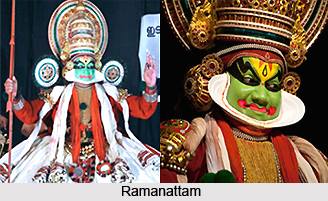 Ramanattam, as the name suggests, is the presentation of the story of Lord Rama in a series of eight plays. It was created under the patronage of Veera Kerala Varma. Ramanattam is based on the story of Ramayana beginning from the incarnation of Lord Rama to the Lanka War, Ravana`s defeat and Rama`s crowning at Ayodhya.
Ramanattam, as the name suggests, is the presentation of the story of Lord Rama in a series of eight plays. It was created under the patronage of Veera Kerala Varma. Ramanattam is based on the story of Ramayana beginning from the incarnation of Lord Rama to the Lanka War, Ravana`s defeat and Rama`s crowning at Ayodhya.
Divisions of Ramanattam
The story was penned by Kottarakkara Thampuran in Manipravalam style which is a form of poetic composition in which words of Malayalam and Sanskrit are blended indistinguishably. It is divided into eight poetic sections so that each of them can be acted in one day. The eight sections are: puthrakameshti, seetha swayamvaram, vicchinnabhishekam, kharavadham, balivadham, thoranayudham, sethubandhanam and yudham (war). It is believed that Ramanattam is the immediate stem of Kathakali.
Origin of Ramanattam
Krishnattam became famous after it was staged by the then Zamorin Raja of Calicut in 1657 AD. The success encouraged the neighbouring chief of the Raja of Kottarakkara to request the Zamorin for loan of a troupe of performers on festive occasion. However, due to political rivalry the Zamorin king refused to send the performers thereby insulting the Raja of Kottarakkara. This rivalry turned into an art rivalry that initiated a parallel mode of entertainment called Ramanattam. Ramanattam was written in Malayalam language.
Similarities betweeon Ramanattam and Kathakali
Kottayathu Thampuran, Raja of Kottayam refined Ramanattam into Kathakali. He belonged to the first part of eighteenth century. He was a poet and a teacher of dramatics who gave a scientific basis to Attakkatha as well as Kathakali literature. The most important contribution of the King to Ramanattam was that he steadied the scientific basis of its literature, music and acting.
In Ramanattam and Kathakali, importance is given to hand gestures and facial expressions. Except make ups, both of these dances have similarities in costumes and music etc. With time, these dances have been reformed and improved.
This article is a stub. You can enrich by adding more information to it. Send your Write Up to content@indianetzone.com




















